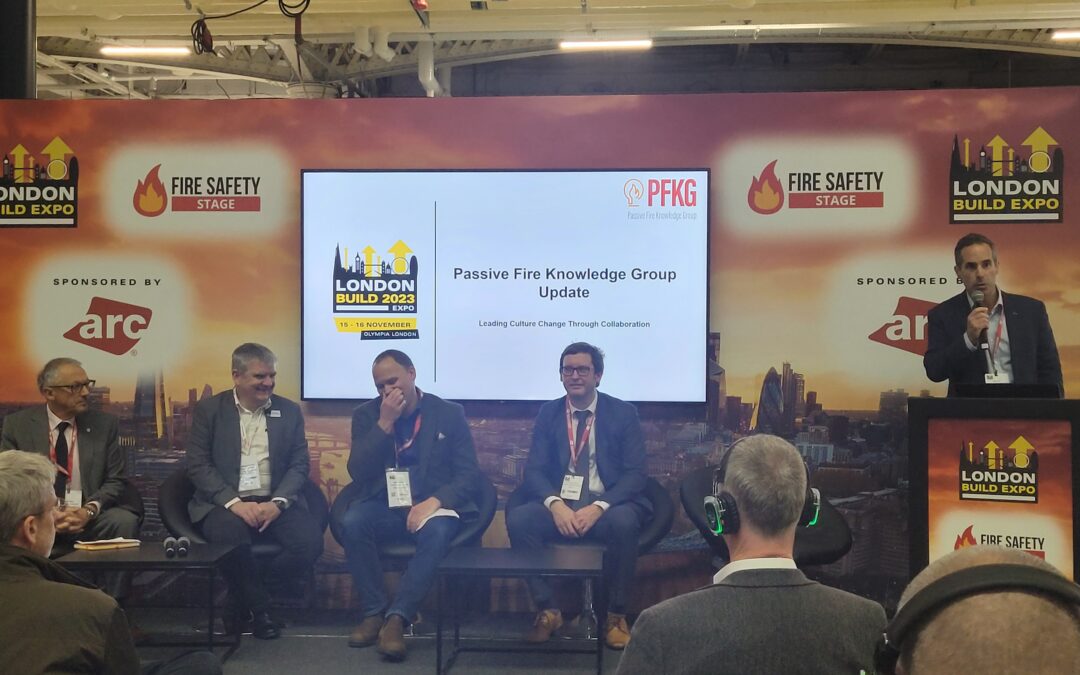
by Clair Mooney | Nov 16, 2023 | Building Safety Act, Technical
A new set of resources looking at penetrations and compatibility were launched today at London Build by the Passive Fire Knowledge Group (PFKG), a collaborative construction forum (co-chaired by FIS Technical Director Joe Cilia).
The PFKG brings together contractors, consultants and relevant trade associations established to encourage collaboration and improve the delivery of well designed, specified and installed passive fire protection by focusing on three key areas: Process, Testing and Education. The group aims to investigate, understand, inform and promote knowledge and research in all areas of passive fire protection and support compliance through the supply chain with the Building Safety Act.
The new resources have been developed to support compliance in the supply chain and cover:
- Knowledge Share 1 – MEP Service Positioning And Separation Within Compartment Walls
- Knowledge Share 2 – Wall Compatibility Checks
- Knowledge Share 3 – Shaft Walls & Services Penetrations
- MEP Services Penetration Seals Best Practice Design And Specification
The resources are available to download from the PFKG website here : https://pfkg.org/reports-2/

by Clair Mooney | Nov 9, 2023 | Building Safety Act
The Housing (Cladding Remediation) (Scotland) Bill has been introduced. The bill seeks to reduce the risk of life from unsafe cladding on people’s homes and will give powers to ministers to assess and remediate certain types of buildings with unsafe cladding. Ministers will then need to record these assessments and any remediation works completed in a register, and the bill also allows ministers to create a responsible developers scheme. The bill has been published as introduced with explanatory notes, alongside a policy memorandum, financial memorandum, delegated powers memorandum and a statement on legislative competence. The Scottish Government has also published a Business and Regulatory Impact Assessment, Equality Impact Assessment and Children’s Rights and Wellbeing Impact Assessment.

by Clair Mooney | Oct 31, 2023 | Building Safety Act
In a written statement to Parliament this week, Secretary of State for Levelling Up, Housing and Communities Michael Gove confirmed the transitional arrangements for second staircases in new residential buildings in England above 18 metres. From the date when the Government formally publishes the changes to Approved Document B, there will be a period of 30 months during which new Building Regulations applications can meet either the existing or the updated requirements. At the end of that period, all applications will be required to meet the updated requirements.
We understand that approved applications that have chosen to follow the existing guidance will have a further 18 months for construction to ‘sufficiently progress’. There will be no requirement to add a second staircase at a later stage provided they are built in accordance with the existing standards, well‐maintained and properly managed.
The Government has also published additional guidance on determining whether a building is a Higher‐Risk Building (HRB) as the definition varies for new buildings, existing buildings, and those ‘in occupation’. It confirms that military accommodation which is over 18 metres or at least 7 storeys and has two or more residential units will be brought into scope of the HRB regime.

by Clair Mooney | Oct 17, 2023 | Building Safety Act
FIS has today launched new guidance – Introduction to the Golden Thread and Digital Information Plans – to help businesses in the finishes and interiors sector get to grips with all the jargon and new regulations associated with the golden thread and digitalisation of construction.
A recent FIS Digitalisation Survey found that 60% of contractors and 44% of product manufacturers and suppliers do not understand what is needed to meet Digital/Golden Thread Requirements in the Building Regulations. In light of these findings, this new FIS guide has been designed to help product suppliers and contractors operating in the finishes and interiors sector cut through the complex terminology and begin to form their own digital plan of work. It draws on published information and principles set down in a myriad of technical and information standards and aligns this to the requirements set down in the Building Safety Act and wider reform of Construction Regulations.
The new guidance provides an overview of the Building Safety Act 2022, the golden thread of information and the new regulatory framework. There is an emphasis on Stage 4 (Technical Design) and Stage 5 (Construction Information) of the RIBA Plan of Work. The guide brings clarity to digitalisation, the new common data environment (CDE) responsibilities and explains how to manage product data and what is needed in order to create a digital information plan. It also explores BIM, digital twins and the role of artificial intelligence.
Commenting on the guide, Iain McIlwee, Chief Executive of the FIS said:
“At the heart of this document is the principle that no one company and no one solution will or should deliver the golden thread alone. It is inherently a collaborative process that should ensure essential information is shared effectively and understood thoroughly. This is the responsibility of all in the supply chain.”
We hope that this new FIS guidance brings clarity and provides an understanding of what is required for companies to form their own digital plan of work.”
You can download the Introduction to the Golden Thread and Digital Information Plans at https://www.thefis.org/knowledge-hub/digital-toolkit/

by Clair Mooney | Oct 10, 2023 | Building Safety Act

by Clair Mooney | Oct 9, 2023 | Building Safety Act






